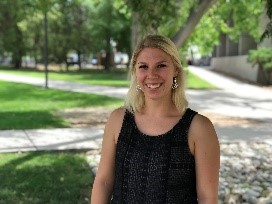American Psychological Association Division 50

Let me start this Student Spotlight by introducing myself. My name is Victoria (Tori) Votaw and I am currently a PhD candidate and NIAAA F31 pre-doctoral fellow at the University of New Mexico. Prior to entering graduate school, I completed my undergraduate training at the University of Kentucky and a post-baccalaureate research assistant position at McLean Hospital. My program of research focuses on improving behavioral and pharmacological treatments for substance use disorders using precision medicine approaches, as well as examining the etiology and consequences of polysubstance use.
Since joining Division 50 in 2017, I have served on the Social Media Subcommittee of the Technology & Communications Committee and I’m currently a member of the Membership Committee and the Student Editor of the SoAP Box. I can undoubtedly say that I have found my professional home within Division 50. Division 50 has numerous opportunities and resources available for members, including student and early career grants, an enthralling podcast, example syllabi for addictions-focused courses, and, of course, the SoAP Box. In conversations with Division 50 members and at the annual Collaborative Perspectives on Addiction meeting, I always feel welcomed and academically stimulated. I’ve observed how mid- and late-career Division 50 members prioritize amplifying the voices of students and early career professionals and aim to improve academic spaces for trainees from diverse backgrounds. Perhaps most importantly, it is clear to me that Division 50 members have a real commitment to improving the lives of individuals with substance use disorders.
Yet, I am also introverted and over-analyze social situations, which means that networking does not come naturally to me. We’re all aware of the importance of networking, whether the goal is to find a postdoctoral or faculty position, obtain new collaborators for a manuscript or grant, or build a mentorship network. Frankly, cold introductions overwhelm me and I used to shy away from such interactions. Over time, I’ve learned ways to network and take full advantage of the opportunities Division 50 has to offer to keep me moving in the direction of my goals.
Join a committee in a professional society. Early on, a mentor who was aware of my anxiety about networking provided me with advice to “network in a way that doesn’t feel like networking.” I soon realized that joining a professional society committee fit the bill. In these roles, you are able to make connections with other committee members while working on projects and shared goals. These situations reduce the awkwardness typical of introductions and, simultaneously, allow you to demonstrate your skillset to colleagues. Oftentimes, roles on professional committees will allow additional opportunities for networking, beyond interactions with committee members. For example, through my role as the SoAP Box Student Editor, I am able to connect with authors of the columns each issue. It is important to note that professional societies vary in their approach to recruiting members for committees. Some professional societies will recruit committee members once annually, typically through a listserv email. Others, like Division 50, recruit committee members on a rolling basis. If you are a student who is interested in joining a Division 50 committee, you can reach out to your student representatives, Melissa Schick (melissa_schick@uri.edu) and Samuel Acuff (sfacuff@memphis.edu). Members can also reach out to Division 50 committee chairs expressing their interest in becoming involved.
Take advantage of networking events and programs. If cold introductions do not feel natural to you, networking events and programs are great ways to make connections. In these spaces, mid- and late-career scientists are explicitly interested in giving their time to connect with students and early career professionals. For example, Division 50 hosts a Mentor Lunch at the Collaborative Perspectives on Addiction meeting. At this lunch, groups of students are matched with senior scientists, based on shared research interests. Mentors tend to be cognizant of the potentially anxiety-provoking nature of the lunch and will guide the conversation through thoughtful questions.
Create a professional Twitter account. Although I was initially hesitant to create a professional Twitter account (“what if I say something unprofessional!?”), this has been one of my favorite ways to connect with other addiction scientists (follow me @victoriavotaw). I recently came across a wonderful resource for beginning a professional Twitter account. One of my favorite pieces of advice from this resource is that you can start small – primarily re-Tweeting and quote Tweeting others. Indeed, this is how I started on Twitter and, over time, I became comfortable enough to use the platform to share recent work and even seek support when encountering academic roadblocks. The Division 50 account (@apadivision50) is also a great way to connect with other members and stay on top of division news and opportunities.
Carefully consider which opportunities to say “yes” and “no” to. The more you get your name “out there” in professional environments (perhaps, through the above-mentioned tips), the more you will be offered other opportunities. Some of these may be intimidating. For example, I was recently invited to be a guest on a student episode of the Addiction Psychologist Podcast. Although this invitation elicited anxiety (“what if I say something incorrect while being recorded!?”), I knew this opportunity was aligned with meeting my ultimate career goals. Here are several questions I ask myself when considering whether to say “yes” or “no” to an opportunity. Am I considering saying “no” purely out of fear? Does this opportunity align with my professional goals and values? Does this opportunity put me in contact with people who could be colleagues and collaborators? Overall, I try to take on opportunities that will move me closer to my goals, without letting anxiety interfere.
Exposure! Even if you choose to network through joining a committee or at a networking event, these situations can still be anxiety-provoking. You may ruminate about your interactions afterwards or think about the worst case scenarios before these meetings and events. As with most anxiety-provoking situations, through repeated exposure we learn that our feared outcomes are unlikely to come true and that it’s not so bad when they do. I often set networking goals to make sure I am sufficiently facing these situations. For example, I might make a point to ask a question after a talk or to introduce myself to a new person once per day at conferences. Before going into networking situations, I also tell myself to expect (and be okay with!) some awkwardness. If I find myself ruminating or worrying about the situation, I try to identify my thinking traps and evaluate the evidence for these thoughts.
I hope these tips help you to take advantage of all the opportunities Division 50 has to offer, even if networking makes you feel anxious too! Although networking does not come naturally to me, I have connected with countless Division 50 members who inspire me to be a better scientist, person, and mentor and have gone out of their way to help me meet my professional goals.

Resources are available for those struggling with addiction and numerous effective treatments exist. Whether you are looking for help for yourself or a loved one, we encourage you to seek out help.